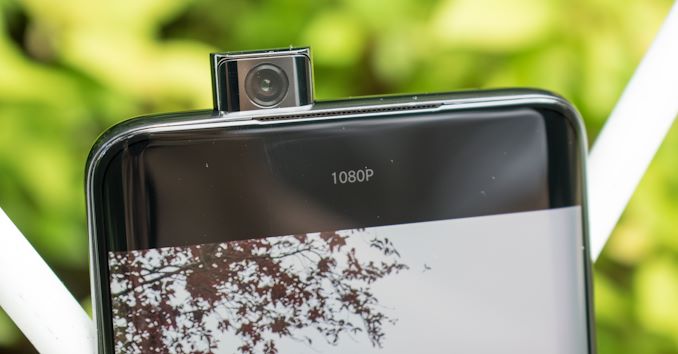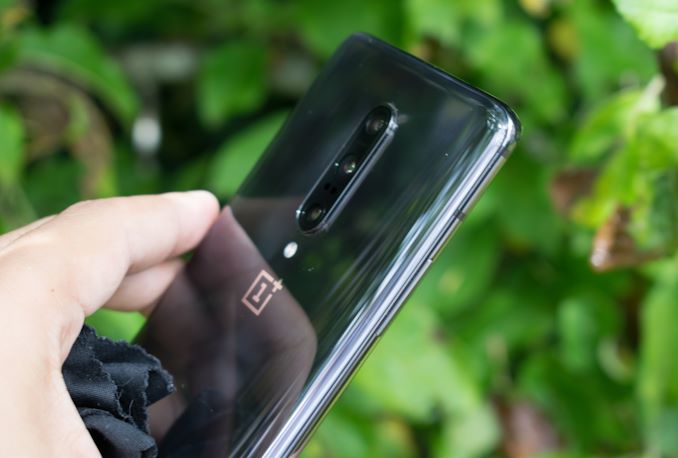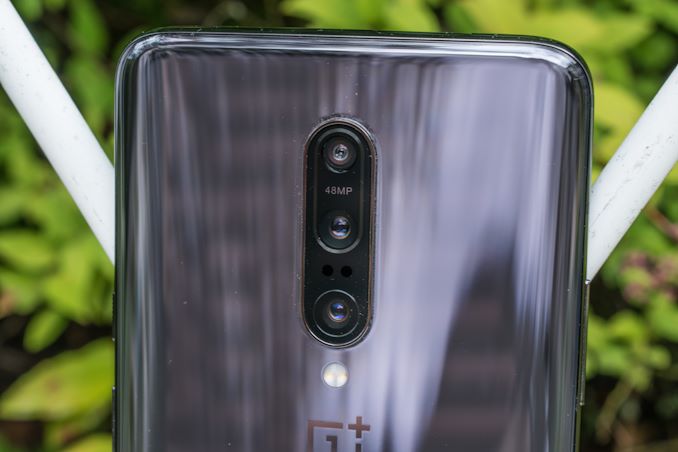The OnePlus 7 Pro Review: Outstanding Performance & Screen, Adequate Everything Else
by Andrei Frumusanu on June 19, 2019 12:00 PM EST- Posted in
- Mobile
- Smartphones
- OnePlus
- OnePlus 7 Pro
Conclusion & End Remarks
As we’re wrapping up this review, the main question for me and a lot of users for is whether the OnePlus 7 Pro is worth the additional cost, and if it makes a successful landing in its new higher price category whilst maintaining the company’s mantra of offering the best value for the money.
In terms of design, I really liked the OnePlus 7 Pro and I had very little to complain about the new form. This is OnePlus’ first curved screen phone, and whilst I think some vendors by experience have gone back to slightly tighter radius curvatures on their displays, for the OP7Pro it’s still something that you can definitely get used to, and it does improve ergonomics a lot.
In terms of ergonomics, my subjective feeling is that this is a bit too big a phone for me, but for users who are looking into iPhone Plus / Max and Galaxy Note-sized devices, it’ll be a perfect fit. It’s also a very heavy device in the same weight category as the aforementioned devices, so this is something you'll want to consider.
The new display of the OnePlus 7 Pro is easily its single best feature. This is not only because it’s OnePlus’ first ever 1440p screen which is a great improvement in sharpness, but it’s the very first OLED 1440p 90Hz screen on the market.
Overall in terms of the fundamentals of the display, the unit does not disappoint. OnePlus did a very good job in terms of colour calibration with the Natural mode and it’s up there among the best devices, and thus far the best Android device screen in 2019. Brightness was an area of improvement, as OnePlus makes you choose between a brighter Vivid mode with inaccurate colours, or an accurate Natural mode which doesn’t quite go as bright as advertised in daylight.
The 90Hz mode is the single biggest killer feature of the phone and there will be people who will be choosing the OnePlus 7 Pro over other contenders solely for this. This was my opinion when I first held the phone, and I maintain this view after spending sufficient time with it. I think that this is the way forward for phone manufacturers to differentiate themselves. It’s just that much of an outstanding experience.
An outstanding experience is also the performance of the phone. The combination of the 90Hz mode with the new Snapdragon 855 SoC as well as the new UFS 3.0 storage employed in the 7Pro means this is currently the snappiest, and best user experience phone out there.
The performance benefits extend to gaming as well: OnePlus was able to achieve a good thermal dissipation design that seemingly is able to sustain peak performance indefinitely, squeeing out the full potential of the Snapdragon 855, although the phone can get a bit toasty and it does eat up a lot of battery like this.
Speaking of battery, the OnePlus 7 Pro is average to good, and essentially ended up where I had expected it to. I don’t have definitive evidence of this, but the new 90Hz screen is largely suspected as the cause for a larger base power consumption. So even though OnePlus has implemented the new feature in the best way possible, there’s still an unavoidable power hit, and the phone doesn’t last as long as say the P30 Pro or Galaxy S10+ even though they're all in the same range in terms of battery capacity.
The 60Hz mode is a novelty and there’s really no reason to use it, you’re better off with a different phone if you’re avoiding the key feature of the OnePlus 7 Pro.
The cameras of the OnePlus 7 Pro is where things become a bit painful and unfortunate.
First of all, let’s get the front-facing pop-up camera out of the way. It’s a good module, but personally I do think the added weight, internal complexity as well as longevity risk (if you get debris inside) are too big compromises. Yes the full bezel-less screen screen is fantastic, but I could have also just lived with a minimal forehead or just a blacked out status bar with a small notch.
In daylight capture, the OnePlus 7 Pro is a good phone and it has a good camera, but it’s not quite competitive against 2019’s flagship devices. In particular we saw that OnePlus’ processing isn’t able to fully extract what’s actually possible with the new camera sensor. The fact that it’s 48MP is generally irrelevant for 99% of users, OnePlus could have simply gone with a traditional 12MP sensor and likely gotten better results.
The processing reminded me a bit too much of the Pixel 3 in daylight, meaning it lacked sufficient dynamic range and it had the bad habit of over-emphasising shadows that weren’t actually there. There’s some shots where the 7Pro is just worse than the 6T.
The wide-angle, while an excellent addition to the overall shooting experience, suffered from the same processing effects as the main camera. On top of this, it’s visible that the module’s lens is of much lower quality than what’s seen by other manufacturers, causing more distortion and bad chromatic aberrations around the frame edges.
The telephoto module was in my opinion good, and got surprisingly very sharp results. The 3x zoom is a good compromise between 2x and some of the newer more crazy high magnification phones.
Low-light capture of the OnePlus 7 Pro would have been something competitive in 2018, however this year OnePlus had to step it up in terms of its computational photography. Cameras are among the very last things a manufacturer works on when designing a new phone, so it’s possible that over the next few months the company will be able to further improve things. However as it stands, the OnePlus 7 Pro falls behind not only the low-light kings from Huawei, but also now falls behind Samsung as the Galaxy phones are getting updated with a significantly better Night mode.
Video recording has also been soundly disappointing for the fact that it feels the OP7Pro’s camera is just unfinished in this regard, and lacks any option to use the wide-angle or telephoto lenses. On the main module, EIS quality is a bit disappointing and there’s a lack of dynamic range, either through captured sensor HDR or actually natively recorded HDR modes.
Speakers on the OnePlus 7 Pro have massively improved compared to its predecessor, so credit where it's due even though they don't quite match Apple or Samsung's offerings.
In the end I see there’s going to be only one type of person who should consider the OnePlus 7 Pro over say a Galaxy S10+: If you value performance and device fluidity more than anything else, the 90Hz display, the SoC, and the storage speed of the OnePlus just beats out any other contender in this regard.
However for me I feel that the phone is cutting a bit too many corner in terms of its camera. I could have lived with the slightly worse speakers and somewhat lower battery performance in order to enjoy the fantastic 90Hz screen, however the camera disadvantages are just a tad too much. OnePlus can very much remedy these aspects over the coming weeks and months, and I’m very sure there will be software updates in this regard, but it's unknown just exactly how much OnePlus will improve these aspects, and one shouldn’t base one’s purchasing decisions today on tomorrow’s possible improvements.













91 Comments
View All Comments
Kishoreshack - Wednesday, June 19, 2019 - link
One plus is a Solid Phonebut
Do you think the Premium Price tag just for the display is justified?
Andrei Frumusanu - Wednesday, June 19, 2019 - link
Compared to the regular OnePlus 7, yes it's justified, at least for me.warreo - Wednesday, June 19, 2019 - link
I think it's unfair to call the OP7P pricing "premium". It's no longer "cheap", for sure, but to get similar specs Samsung or Pixel will run you $1000, $300 more than the OP7P.1_rick - Wednesday, June 19, 2019 - link
$700 is absolutely a premium price, when mid-tier phones cost half as muchjordanclock - Wednesday, June 19, 2019 - link
Just because the price ceiling has been rising doesn't mean the minimum to call a phone premium has followed suit.cha0z_ - Monday, July 1, 2019 - link
This is absolutely not true, galaxy s10/s10+ can be found a lot cheaper now and I am not even talking about contracts with mobile operators that will reduce the price even further going below opo 7 pro (and is not an option for opo 7 pro).Kishoreshack - Wednesday, June 19, 2019 - link
The phone tries to achieve smoothness of IOS but loses on polishing on the UIThere are some bugs which can be addressed
but I'm not sure whether they will address
battery
&
camera issues
Kishoreshack - Wednesday, June 19, 2019 - link
UFS 3.0 ZERO IS JUST A GIMMICKAS it faulters in Random I/O
S10+ plus performs better than it
One Plus is slowly becoming a Marketing Gimmick Phone
RSAUser - Wednesday, June 19, 2019 - link
Definitely not, UFS 3.0 is about 50% faster in random IO. The S10+ in the benchmark can be a fluke, especially if they were testing the 1TB model as there would be a lot less fragmentation (plus more RAM).Then price difference. Next Samsung Note 10 will use UFS 3.0, will be interesting what happens there.
And remember it's a standard, not an exact definition, OnePlus just needs to reach UFS 3.0 standard minimums for the connector/type, doesn't mean they have to implement the max capable. Same as SATA 3 random random IO still isn't maxed, since the drives themselves can't max the link, that's the wrong bottleneck.
Teckk - Wednesday, June 19, 2019 - link
So the jump from 6/128 GB to 8 GB/128 is only 30$? But an additional 4 GB RAM is 100$ more?